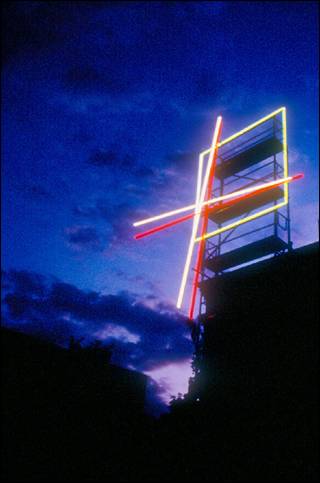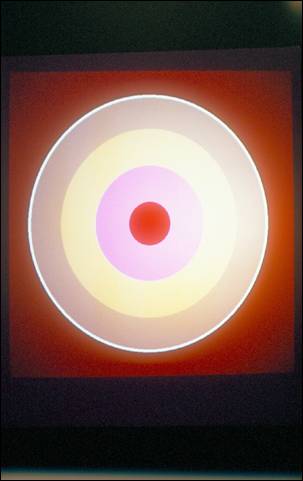Thorbjørn Lausten is working with light, space and time, and the interactivity of the surroundings influencing the development of the work – it can be from the audiences, from the temperature of the surroundings, from radio waves received from the outer space etc. In this kind of work, the experience of exhibition space is expanded enormously.
In his first work of light art, Pointany-X, 1972, one light bulb was moving and switched on and off activated by the sound that the spectator made clapping his hands.
During many years, Lausten in his art has been concerned with visualization of scientific data – visualizing not as illustrations, but using the scientific data digitally transformed via computer into the language of visual art.
Very often Lausten has worked with scientists to develop the systems and contents behind the actual work of light. He is one of very few, Danish artists who work in the field of art-and-science.
His visual artistic language is very controlled and can understood in the tradition of geometrical constructivism.
I will list a few works, that give an idea of the range of Lausten´s work.
Relator, 1985 - is a wooden construction measuring 2 x 3 x 3 m., with six 500 watt bulbs, controlled by a microprocessor. 3 of them are switched on and off, writing in Morse code: “Time, Space, Energy”. 2 of the lamps are on/off according to a mathematical series. The 6th is lit, when the 2 former are off.
Inter-actor, 1989 - The projectors are hanging at a low height, physically dominating the exhibition space. Via photo cells, persons entering the room activate the projectors, which start to blink. Via radio transmission this information is send to 2 large, strong projectors outside the exhibition house, that are on, when the projectors in the room are off, and vice versa.
Craggs projections, Edinburgh, during Lux Europae 1992/93.Four Xenon spotlights of 2500 watt each are projecting onto a cliff, the projection field is 17 x 60 meters. The four forms are essential: Square, Triangle, Circle and Cross; the cross is constantly rotating, one rotation pr minute.
Lightwork, 1993 in Hamburg, measuring 8 x 8 meter, in open air near a railroad. It consist of various parts, neon tubes. One, a red cross is on day and night, the other parts are activated, when a subway train passes.
Arena, Århus, Denmark, 2001-2002. The installation is 87 metres long, the different tubes are switched on-off in a 60 minute sequence
Wired, 2002, (one of a series) The tubes are up to 250 cm long, they are on-off in a 28 minute sequence.
Now - The Polar Space, 1996
The installation consisted of 10 projections of 3 x 5 meters each showing computer graphics changing in time, each repeating itself after about 5 minute
The images were visualisations of phenomena occurring in the nature of Greenland, several thousand kilometres north of Denmark. Greenland is a self governed part of the Kingdom of Denmark.
The scientific data derived from: the meteorological observations from weather stations all around Greenland during two years; the condition of the ozon layer during one year; the composition of ice core; a magnetic storm; the movement of narwhales; the path of polar bears; data about plants and birds. Even though the exhibition was called “Now” is was mostly recorded data. Nevertheless during the overwhelming projections one felt, that we were meeting something happening now, presented through a very strong visual-linguistic transformation.
Lausten has during the latest years continued this kind of work on visual-linguistic presentation of data from satellites registrateing phenomena such as infra red observations of the globe, solar winds, sun spots and the like, as in Sol, 2004-05, shown in Denmark, Graz, ZKM, Genoa and Japan.
He is working with the conceptualisation of a complex reality, that we get to know through the scientific research. We cannot see that part of reality, may be we cannot even understand it, but this technological world is our daily life reality. Everything can be digitalized and therefore also be visualized.
Thorbjørn Lausten was born in 1945. He is a self taught artist. In 1987 he got a grant from the Pollock Krasner Foundation, New York, 1987-88 visiting artist at Massachusetts College of Art, Boston; 1988-89 he was a research fellow at the Center for Advanced Visual Studies at Massachusetts Institute of Technology; 1989 Artist in residence, Djerassi Foundation, California..
Lausten has a number of light art works in public locations. His web site: www.luxpress.dk.

